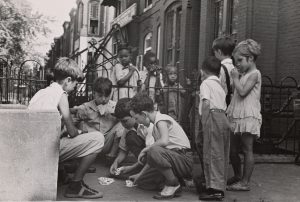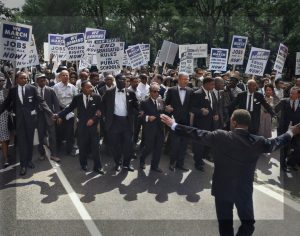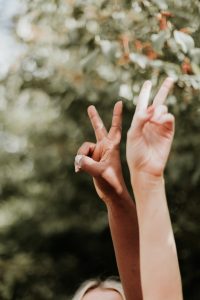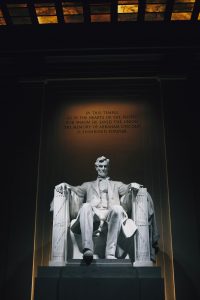 By Al Guart
By Al Guart
At the age of seven, in a moment of unexplained optimism, I strolled into the troubled Red Hook projects. It was 1965 and my skin was white. Only Blacks lived in the projects and race relations in America were abysmal. For example, in March of that year, 600 civil rights protesters were beaten and tear gassed marching in Alabama in a televised incident later known as “Bloody Sunday.”
But Mister Rogers assured me it was a lovely day in the neighborhood. A Black classmate named Ernest lived in the “Projects.” Ernest was born January 1st, and I the very next day. He had taken pity on me after watching me get into scrapes in the almost entirely Black P.S. 27. Ernest taught me to hold up my fists, and while my opponent looked at my hands, kick them in the groin. How bad could the projects be if Ernest lived there?
It was a mild, sunny day when I entered the compound and stepped onto the concrete paths that led from one brick building to another. The walkways were lined with galvanized stanchions with chains running through them to keep people off the patchy grass. Ahead of me on the walkway stood a Black boy about my age. As I approached, I saw anger in his eyes. Perhaps I had grown immune to the hate, because my attention was drawn to his shoes: Buster Browns I’d seen on television commercials and wanted so badly. They were orange leather with matching laces and white rubber soles. We silently faced each other, then he kicked me in the groin. Buster … Brown … why?
An adult Black man jumped up from a bench and ran toward us. He, too, had angry eyes. I grew nervous when he brushed past my assailant and stood behind me. He placed his hands under my armpits, lifted me into the air and dangled me in front of the other boy.
“Kick him,” the angry man demanded.
“I don’t want to kick him,” I said.
“Kick him, I said!”
I looked down at the boy frozen in fear below me. My foot struck him in the neck and he clutched his throat. Tears ran down his face, making me sorry for what I’d done. The man put me down and scolded the boy. “Don’t you ever do anything like that again!” he yelled.
The angry-eyed adult then turned to me. “And you. Go back to wherever you came from.” He spun me around and I began retracing my steps. As I walked home, I was confused about what had just happened. Was it really a beautiful day in the neighborhood?

Civil Rights and Wrongs
The 1960s, like today, were a time of racial turbulence. Unlike many White Americans, Red Hook granted me a front row seat. Raised by my mother’s side of the family from Puerto Rico, I had no concept of race. My grandmother was a brown-skinned Taino. My mother was White with blue eyes, resembling her Spaniard father. Some aunts and uncles were dark, some light. Even though I was part Puerto Rican, I was also part Spanish (my grandfather immigrated from Spain) and part Italian (on my absentee father’s side). So, outwardly I appeared White with green eyes and sandy brown hair. None of this mattered to us. We celebrated our differences.
But skin color mattered a great deal to others. The first inkling of this was the morning a boy glared at me as we waited for the school crossing guard to wave us on. “You White cracker,” he said. It took a moment for me to realize he was referring to my skin. “You Oreo cookie,” I shot back.
Many racial incidents followed. Once three Black boys mugged me for a candy bar, calling me “White boy” and noting I had a “small mouth.” Adding to my troubles was my sworn duty to protect my two younger, blonde-haired, blue-eyed, half sisters. Once I confronted a Black boy my sister pointed out who had bothered her repeatedly and refused to stop. After some harsh words he seemed to acknowledge my sister had an older brother who was ready to stick up for her.
But as we exchanged words, a rowdy group of older, Black, junior high school kids formed around us. The crowd wasn’t satisfied with our detente. They closed in around us, shouting and shoving us into each other over and over again. He and I circled each other with our fists raised, each refusing to throw the first punch. We instinctively tried to satisfy the mob’s rising bloodlust with a couple of swings and misses, only to incur more shoves from spectators. Finally, my sister appeared with my aunt, who waded into the crowd and took me home.
About 1968, the New York City Board of Education launched the Intellectually Gifted Children’s program. Some of us took a test and were admitted to the IGC, which required us to be bused into a “White” school. At the same time, forced school busing to integrate public schools began.
What it meant for me was I had to wait for the bus in the Red Hook projects every morning with Black kids who were being forced into the same White schools. My fellow students discovered I could flex my stomach muscles enough to take a punch. Soon it was a morning tradition for them to stand in line and take turns getting one punch into my stomach until the bus came, the line ended or something else distracted them. It was better than bloody fist fights.

A Visionary Call for Unity
I was relieved by Dr. Martin Luther King’s calls for racial unity, for people to look beyond skin color to see others for who they were inside. While others incited racial hatred and violence, King insisted on non-violence and harmony. “I have a dream that my four little children will one day live in a nation where they will not be judged by the color of their skin but by the content of their character,” he famously said.
In 1968, my family moved to the nearby poor section of Park Slope. We rented a house on a street of single family homes and small factories. There was one Black family on the block, most residents being of Norwegian, Italian or Irish descent. It felt good not to stand out or be called a “cracker” or “White boy.” However, my newfound friends soon discovered I was part Puerto Rican and I resigned myself to being called a “Spic.” That was okay, because I learned to call them Square Heads, Wops and Micks. We all got along somehow.

Reflections on the Dream
Decades of reflection on those early years taught me we are members of one human race who share common experiences. Everyone will endure failure and celebrate success, feel both anger and compassion, suffer rejection and enjoy acceptance. We will all be born to a mother, struggle to find our way and feel the sting of prejudice. Everyone will lose loved ones and eventually die. Regardless of skin color, when it comes to the major events comprising a life, we have much in common.
I also learned racial bigotry is learned and is not limited to one race. Good people teach their young not to hate others for their skin color, ethnic background, religious beliefs or anything superficial. I’ve learned discrimination exists among people of the same race. Blacks from Africa or the Caribbean don’t always mix with those from America. Koreans, Chinese and Japanese don’t always get along. Whites fight each other along nationality lines. However, we can come together based on the human experiences we share.

Undeniable Progress
Americans today are rightly confused. The nation that abolished slavery after a brutal civil war claimed the lives of 1.5 million American men is once again witnessing racial unrest. Despite the hard won changes of the civil rights era, you might think nothing has improved. But it has. Affirmative action, the right to vote, all Black colleges, the War on Poverty, Black radio stations and television networks, opportunities that have created Black millionaires and business executives, world-famous musicians and Hollywood actors should give us hope. Americans elected and re-elected our first Black President. Black politicians have run entire major cities like New York, Detroit and Chicago. Large school systems are led by highly credentialed Black educators. Similarly, police departments and the military have become integrated. Marriages between Blacks and Whites increased by 400 percent over the past 30 years. Yet, if you listen to some voices and trust the mainstream media, you’d think none of this happened. We need to acknowledge and appreciate the strides we’ve made together.
When will we reach the mountaintop? When there are no inner cities marked by gun violence, drug addiction, unemployment and under-performing schools. When hiring quotas and exclusively Black institutions are no longer justified. When we are no longer preoccupied with race. For this, we need leaders with a capacity to look beyond skin color, leaders with the mortal authority to call out those who foment racial hate for their own political and financial gain. We need visionaries who train their eyes on the prize Dr. King dreamed of: a world where people are no longer captive to the distractions of race, ethnicity or religious belief and no longer torment each other over historical wrongs. We need leaders who will not fall prey to “White guilt” but who will fight for fairness for all. These leaders can be of any color you choose.


